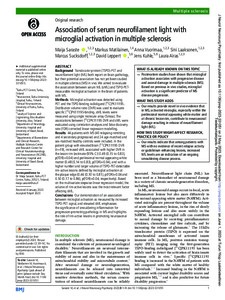Association of serum neurofilament light with microglial activation in multiple sclerosis
Saraste Maija; Matilainen Markus; Vuorimaa Anna; Laaksonen Sini; Sucksdorff Marcus; Leppert David; Kuhle Jens; Airas Laura
https://urn.fi/URN:NBN:fi-fe2025082790934
Tiivistelmä
Backround: Translocator protein (TSPO)-PET and neurofilament light (NfL) both report on brain pathology, but their potential association has not yet been studied in multiple sclerosis (MS) in vivo. We aimed to evaluate the association between serum NfL (sNfL) and TSPO-PET-measurable microglial activation in the brain of patients with MS.
Methods: Microglial activation was detected using PET and the TSPO-binding radioligand [11C]PK11195. Distribution volume ratio (DVR) was used to evaluate specific [11C]PK11195-binding. sNfL levels were measured using single molecule array (Simoa). The associations between [11C]PK11195 DVR and sNfL were evaluated using correlation analyses and false discovery rate (FDR) corrected linear regression modelling.
Results: 44 patients with MS (40 relapsing-remitting and 4 secondary progressive) and 24 age-matched and sex-matched healthy controls were included. In the patient group with elevated brain [11C]PK11195 DVR (n=19), increased sNfL associated with higher DVR in the lesion rim (estimate (95% CI) 0.49 (0.15 to 0.83), p(FDR)=0.04) and perilesional normal appearing white matter (0.48 (0.14 to 0.83), p(FDR)=0.04), and with a higher number and larger volume of TSPO-PET-detectable rim-active lesions defined by microglial activation at the plaque edge (0.46 (0.10 to 0.81), p(FDR)=0.04 and 0.50 (0.17 to 0.84), p(FDR)=0.04, respectively). Based on the multivariate stepwise linear regression model, the volume of rim-active lesions was the most relevant factor affecting sNfL.
Conclusions: Our demonstration of an association between microglial activation as measured by increased TSPO-PET signal, and elevated sNfL emphasises the significance of smouldering inflammation for progression-promoting pathology in MS and highlights the role of rim-active lesions in promoting neuroaxonal damage.
Kokoelmat
- Rinnakkaistallenteet [27094]
